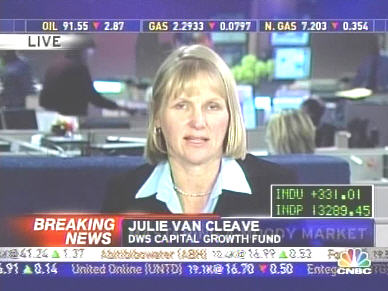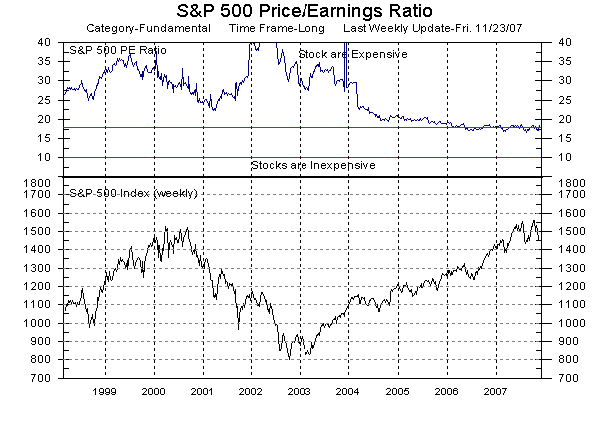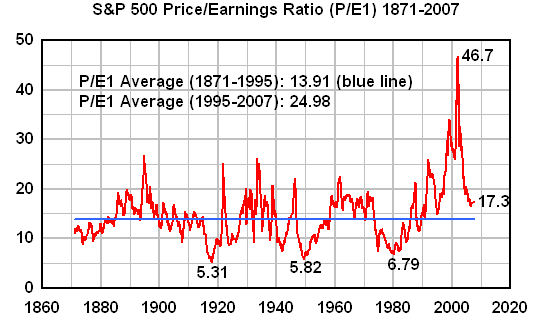
Dynamics

|
Generational Dynamics |
| Forecasting America's Destiny ... and the World's | |
| HOME WEB LOG COUNTRY WIKI COMMENT FORUM DOWNLOADS ABOUT | |
It was the biggest two-day Dow Industrials increase in five years, and everyone wore a smile a mile wide on CNBC on Wednesday.
On Tuesday, investors had gotten all excited when the nice oil sheiks in Abu Dhabi agreed to bail out Citibank.
On Wednesday, a Fed Governor gave a speech and supposedly hinted that the Fed would cut interest rates again, when the FOMC (Federal Open Market Committee) meets next on December 11.
That's all it took to push the Dow Industrials up 311 points on Tuesday.
Here's how a Financial Times article explained what happened:
Mr Kohn, the number-two official at the central bank, said the Fed would be "flexible and pragmatic" in responding to new risks to growth arising from the relapse in financial markets."
Now, I read through Kohn's complete speech, and you can do the same, but I don't see any "clear hint" at all. The 2000 word speech discusses the Fed balancing act -- promoting financial stability while avoiding moral hazard -- and concludes with the following:
So yes, the phrase "flexible and pragmatic policymaking" does appear in the next-to-last sentence of the speech, but it refers to the balancing act of financial stability versus moral hazard. It's a thin reed on which to base a stock-buying orgy. Nonetheless, investors have succumbed to full-scale bipolar disease for several weeks now, and after a long depressive period, it was probably time for a manic episode.
 |
I did make note of some particularly amusing statements made on CNBC on Wednesday, so that I could share them with you, Dear Reader.
Here's one from Phil Roth, chief technical market analyst at trading firm Miller Tabak:
This is exactly the kind of "bad news is good news" statement that I keep talking about. So if you've recently become unemployed, and you can't find another job, you should be aware that it's good news, and that a you're very lucky person. Even more important, you're helping the wealthy Wall Street investors make more money, and that's what counts in life.
 |
And now, here's the funniest statement of all on CNBC on Wednesday:
This brief statement is so wrong on so many levels that it's hard to know where to begin. It's typical of what we hear on CNBC, and I wish the quote had come from a male, so that I can't be accused of picking on a girl, especially a blonde. But male or female, blonde, brunette or redhead, this kind of blithering stupidity is the norm.
She says that "we've got a 14 multiple on the market." What does that mean? It means that the price/earnings ratio index is 14. But readers may have noted that there's a price/earnings ratio chart at the bottom of this web site's home page, and it gets updated automatically every Friday. Here's the November 23 version of the chart:
 |
As you can see from the above graph, the P/E ratio is not 14. It's actually around 17-18. The question is: Where did Van Cleave get the figure 14 from?
The answer is that she's using the wrong value for earnings. The P/E ratio should be computed by dividing the stock price by the company's earnings per share for the last year. But Van Cleave isn't doing that, because that would give an embarrassing result.
Van Cleave is using so-called "forward earnings," the bloated estimates for earnings in 2008. By using a bloated value for earnings, the P/E ratio becomes smaller. What Van Cleave computed is total gibberish.
And this is a woman who probably makes over a million dollars per year investing other people's money in the stock market.
What you should understand, Dear Reader, is that YOUR pension fund, your 401k, your stock market or hedge fund broker -- the people managing YOUR hard-earned money are, like Van Cleave, too stupid to know how to compute a price/earnings ratio.
Computing the price/earnings ratio isn't exactly rocket science. Someone would have to be unbelievably stupid to be unable to learn it. And yet, Van Cleave and other people who manage YOUR money are just that stupid.
It doesn't stop there.
She says, "which is very low in any of the last 10 years." But look at this graph of P/E ratios for the last century that I've posted several times:
 |
Now as you can see, the P/E ratio index was ENORMOUSLY above average for the last ten years, by historical standards, and so to compare today's value to the last 10 years is moronic.
I don't expect the "man on the street" to necessarily understand these things. But I DO expect someone who earns millions of dollars managing other people's money to understand them.
And yet, Van Cleave is not only TOO STUPID to even know how to compute a price/earnings ratio, she's also TOO STUPID to know what the historical average is. And remember, this idiot or someone like her is managing your pension fund.
Let's go on to the third common error, though not one used by Van Cleave on this day.
Very often you hear some so-called expert on CNBC use the phrase "reversion to the mean," or "is reverting to the mean," to indicate that some long-term index is getting closer to its long-time historic average or mean value.
For example, some so-called genius might say, "the P/E ratio is getting close to 14, so it's reverting to the mean, so stocks are cheap again."
This is total nonsense. The Principle of Mean Reversion is not "reversion TO the mean"; it's "reversion OF the mean."
It's not the current P/E ratio that has to revert to 14; it's the mean or average that has to revert to 14. And the only way that can happen is for the current P/E ratio to go much lower -- around 5 or 6, as has happened several times in the last century, most recently in 1982 -- and stay very low for many years, so that the AVERAGE will get back down to 14.
I realize that to understand this concept requires several advanced degrees in higher mathematics, and so we can't expect Van Cleave and other financial experts to understand it when they're too stupid even to know how to compute the P/E ratio in the first place.
I just can't get over the sheer day by day stupidity of these people. It never ceases to astound me and infuriate me.
The only thing I can't figure out is whether they're being incredibly stupid or incredibly dishonest. It's quite possible that Van Cleave and others like her are very well aware that they're lying, and therefore they're committing fraud on their clients. If you're a client of one of these people, I definitely think you should start preparing your lawsuit for fraud and make these people pay dearly for their dishonesty and lack of ethics. They deserve the worst punishment they can get.
Now still you may be thinking, "Gee, who cares? The markets went up 2½% to 3% on Wednesday, so everything is going great!!"
Well just take a look at my Dow Jones historical page, and check out what happened on Monday, October 7, 1929 (1929-10-07) -- notice that the market went up 6.32% on that one day alone. You can just imagine the smiles and laughter of investors on that day. And look at how much the stock market continued to gain throughout the entire week. Then, check out what happened just two weeks later.
That doesn't mean that we're going to have a stock market crash in two weeks, though we might. What it means is that Wednesday's 3% gain is not a sign of market strength; it's a sign of a drunken orgy at a time of great investor desperation.
From the point of view of Generational Dynamics, we're overdue for a
stock market panic and crash. It might come next week, next month or
next year, but it's coming with absolute certainty, and probably
sooner rather than later.
(29-Nov-07)
Permanent Link
Receive daily World View columns by e-mail
Donate to Generational Dynamics via PayPal
Web Log Summary - 2016
Web Log Summary - 2015
Web Log Summary - 2014
Web Log Summary - 2013
Web Log Summary - 2012
Web Log Summary - 2011
Web Log Summary - 2010
Web Log Summary - 2009
Web Log Summary - 2008
Web Log Summary - 2007
Web Log Summary - 2006
Web Log Summary - 2005
Web Log Summary - 2004
Web Log - December, 2016
Web Log - November, 2016
Web Log - October, 2016
Web Log - September, 2016
Web Log - August, 2016
Web Log - July, 2016
Web Log - June, 2016
Web Log - May, 2016
Web Log - April, 2016
Web Log - March, 2016
Web Log - February, 2016
Web Log - January, 2016
Web Log - December, 2015
Web Log - November, 2015
Web Log - October, 2015
Web Log - September, 2015
Web Log - August, 2015
Web Log - July, 2015
Web Log - June, 2015
Web Log - May, 2015
Web Log - April, 2015
Web Log - March, 2015
Web Log - February, 2015
Web Log - January, 2015
Web Log - December, 2014
Web Log - November, 2014
Web Log - October, 2014
Web Log - September, 2014
Web Log - August, 2014
Web Log - July, 2014
Web Log - June, 2014
Web Log - May, 2014
Web Log - April, 2014
Web Log - March, 2014
Web Log - February, 2014
Web Log - January, 2014
Web Log - December, 2013
Web Log - November, 2013
Web Log - October, 2013
Web Log - September, 2013
Web Log - August, 2013
Web Log - July, 2013
Web Log - June, 2013
Web Log - May, 2013
Web Log - April, 2013
Web Log - March, 2013
Web Log - February, 2013
Web Log - January, 2013
Web Log - December, 2012
Web Log - November, 2012
Web Log - October, 2012
Web Log - September, 2012
Web Log - August, 2012
Web Log - July, 2012
Web Log - June, 2012
Web Log - May, 2012
Web Log - April, 2012
Web Log - March, 2012
Web Log - February, 2012
Web Log - January, 2012
Web Log - December, 2011
Web Log - November, 2011
Web Log - October, 2011
Web Log - September, 2011
Web Log - August, 2011
Web Log - July, 2011
Web Log - June, 2011
Web Log - May, 2011
Web Log - April, 2011
Web Log - March, 2011
Web Log - February, 2011
Web Log - January, 2011
Web Log - December, 2010
Web Log - November, 2010
Web Log - October, 2010
Web Log - September, 2010
Web Log - August, 2010
Web Log - July, 2010
Web Log - June, 2010
Web Log - May, 2010
Web Log - April, 2010
Web Log - March, 2010
Web Log - February, 2010
Web Log - January, 2010
Web Log - December, 2009
Web Log - November, 2009
Web Log - October, 2009
Web Log - September, 2009
Web Log - August, 2009
Web Log - July, 2009
Web Log - June, 2009
Web Log - May, 2009
Web Log - April, 2009
Web Log - March, 2009
Web Log - February, 2009
Web Log - January, 2009
Web Log - December, 2008
Web Log - November, 2008
Web Log - October, 2008
Web Log - September, 2008
Web Log - August, 2008
Web Log - July, 2008
Web Log - June, 2008
Web Log - May, 2008
Web Log - April, 2008
Web Log - March, 2008
Web Log - February, 2008
Web Log - January, 2008
Web Log - December, 2007
Web Log - November, 2007
Web Log - October, 2007
Web Log - September, 2007
Web Log - August, 2007
Web Log - July, 2007
Web Log - June, 2007
Web Log - May, 2007
Web Log - April, 2007
Web Log - March, 2007
Web Log - February, 2007
Web Log - January, 2007
Web Log - December, 2006
Web Log - November, 2006
Web Log - October, 2006
Web Log - September, 2006
Web Log - August, 2006
Web Log - July, 2006
Web Log - June, 2006
Web Log - May, 2006
Web Log - April, 2006
Web Log - March, 2006
Web Log - February, 2006
Web Log - January, 2006
Web Log - December, 2005
Web Log - November, 2005
Web Log - October, 2005
Web Log - September, 2005
Web Log - August, 2005
Web Log - July, 2005
Web Log - June, 2005
Web Log - May, 2005
Web Log - April, 2005
Web Log - March, 2005
Web Log - February, 2005
Web Log - January, 2005
Web Log - December, 2004
Web Log - November, 2004
Web Log - October, 2004
Web Log - September, 2004
Web Log - August, 2004
Web Log - July, 2004
Web Log - June, 2004